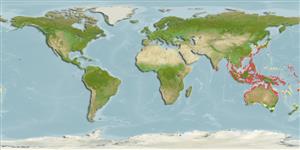Common names from other countries
Environment: milieu / climate zone / depth range / distribution range
Écologie
; profondeur 0 - 10 m (Ref. 349). Tropical
Indo-West Pacific.
Length at first maturity / Taille / Poids / Âge
Maturity: Lm ?, range 4 - ? cm Max length : 12.0 cm ShH mâle / non sexé; (Ref. 349); common length : 9.0 cm SHL mâle / non sexé; (Ref. 349)
Description synthétique
Morphologie
The shell is thin, elongate-ovate in outline with slightly protruding spire. Outer lip slightly sinuous in the middle. Outer surface almost smooth. Holes ovate, nearly flush with surafce of shell, the last 5 to 7 holes open. Colouration: Shell shiny, olive green or brown, with several triangular patches of pale green or cream. Inside of shell highly iridescent (Ref. 128042).
Actively collected in the Southeast Asian countries, for its shell and large fleshy animal (Ref. 349). Found in intertidal, on corals (Refs. 75835, 128042). Common, but not aggregating in dense populations. In life, the exceptionally large green mantle almost covers the shell, which is then devoid of encrusting marine growths, unlike those of the other species (Ref. 349). Very active at night (Ref. 799). Feeds on epilithic algae by grazing (Ref. 85382).
Members of the order Patellogastropoda are mostly gonochoric and broadcast spawners. Life cycle: Embryos develop into planktonic trocophore larvae and later into juvenile veligers before becoming fully grown adults.
Poutiers, J.M. 1998. (Ref. 349)
Statut dans la liste rouge de l'IUCN (Ref. 130435)
statut CITES (Ref. 108899)
Not Evaluated
Not Evaluated
Utilisations par l'homme
Pêcheries: commercial
| FishSource |
Outils
Sources Internet
Estimates based on models
Preferred temperature
(Ref.
115969): 24.3 - 29.3, mean 28.6 (based on 2643 cells).
Vulnérabilité
Low vulnerability (10 of 100).
